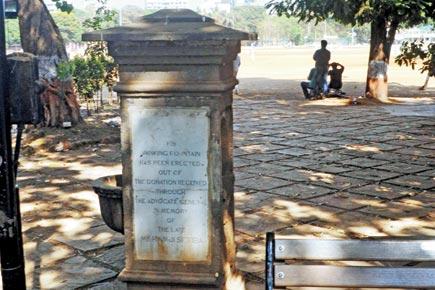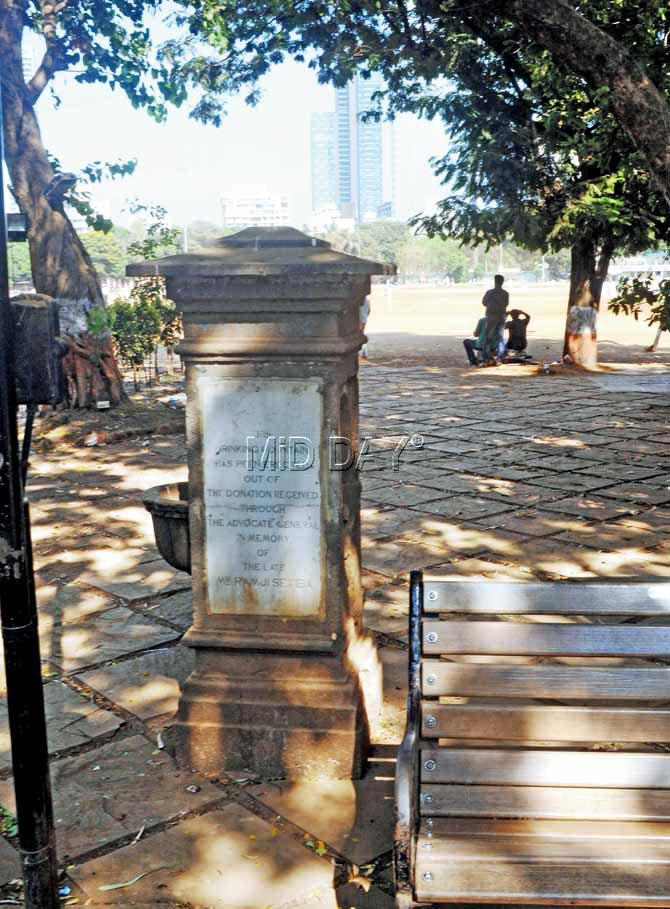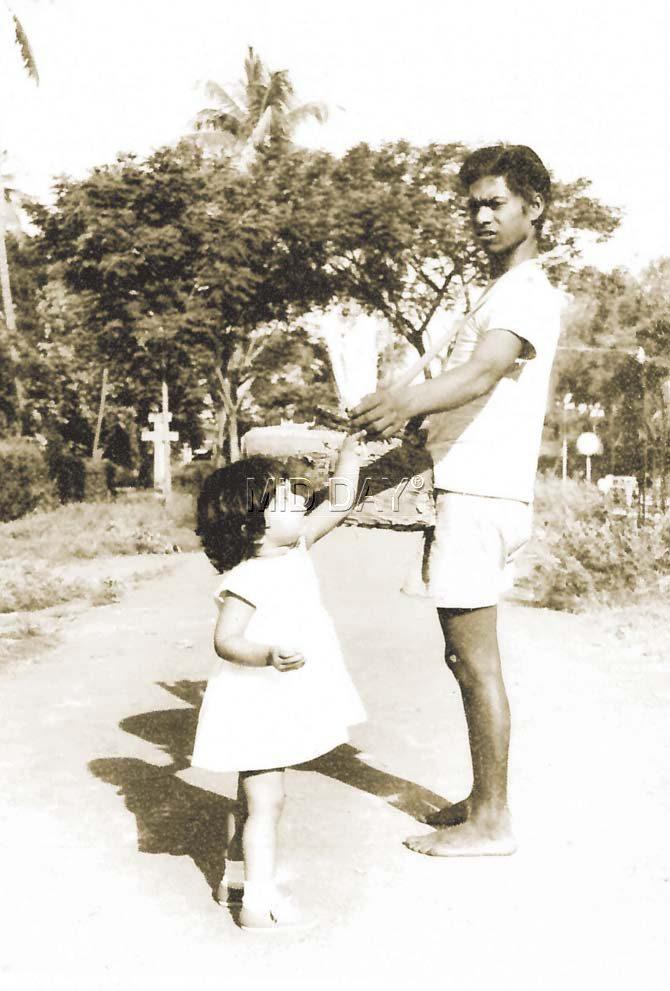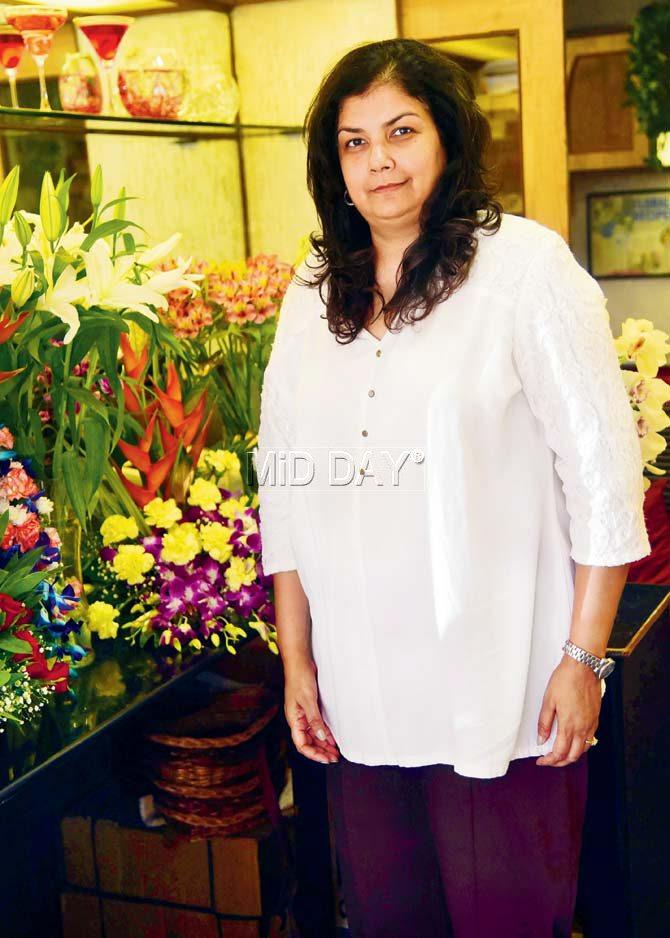The homes around Shivaji Park have some warm tales to tell about Bombay's friendliest public ground since the 1920s

homes around Shivaji Park, warm tales, Bombay's friendliest public ground, since 1920s, Mumbai Guide

The inscription on this pyaav notes it was built to commemorate Ramji Setiba from a donation the advocate general received. Pic/Datta Kumbhar
"At an age kids are taught ABC, I learnt lisping CDP!" she laughs. "Chevrolet, Dodge, Plymouth. My car-crazy father taught me which was which sitting there," says Anuradha Chaubal Shah, pointing to part of the squat parapet that circles Shivaji Park.
ADVERTISEMENT
Kindness is endemic to this column. It thrives on the warmth of people opening up their past to recount the way we were in a more intimate city. Total stranger turned friend, Anuradha strolls me through the ring of buildings around this park where she grew up. The film professional reveals special moments: "I shared secrets with my best pal on this porch" to "That's where we cheered Ram Leela performances - Ram was adored, yet some of us leaned towards feistier Laxman."
A public adda radiating remarkable positivity and inclusion, Shivaji Park has never raised railing barricades. It extends al fresco Bombay's most level embrace. Easier accessible than Oval and Azad maidans, its katta culture is both gift and invitation. This living room of the city asks everyone to take a seat on its simple kerb edge. So they do, runners to flaneurs, resting awhile, watching the world fly by.

A chana walla at Shivaji Park with one of his youngest customers, a little over a year old Anuradha Chaubal in 1960
Created in 1925 by the Bombay Municipal Corporation, this was called Mahim Park till 1927: the Maratha ruler's 300th birth anniversary year saw it renamed Shivaji Park at BMC councillor Avantika Gokhale's behest. With Dadar and Matunga, the City Improvement Trust conceived Shivaji Park to decongest the Fort area after the 1890s plague. Low-slung buildings knitted close owners and tenants from 1936. They formed a U-shaped crescent of ground plus two floor structures along Keluskar Road.
Adapting global Art Deco ideas, local architects assigned them vernacular symbols like the lotus and swastika.
The park-front main street's old and new names are strangely connected. Cadell Road took after Major Thomas Cadell, chief commissioner of the Andaman and Nicobar islands in the late 1900s. Veer Savarkar Marg honours the patriot imprisoned at the Cellular Jail there 50 years later.
The grounds hold Shivaji Park Gymkhana, Bengal Club, Maharashtra State Bharat Scouts and Guides Pavilion, 1922-established Nagarik Sangh and Samarth Vyayam Mandir, founded in 1925 by wrestler PL Kale Guruji, where Uday Deshpande has trained kids at mallakhamb for 40 years. Facing them are Mahatma Gandhi Olympic Pool, Vanita Samaj hall, Keraleeya Mahila Samaj nursery from 1909 and the contentious Mayor's Bungalow.
Shivaji Park revels in legendary twin avatars: cradle of city cricket and hotspot of state politics. Noisier nearing Maharashtra Day, it's pounded by parade practice when I visit. This is seasoned soil, witness to bravura speeches at rousing rallies: Tilak to Thackerays, Mahatma to Samyukta Maharashtra Chalval struggling for the 1960 consolidated state. That movement earned socialist writer PK Atre, who led it, the title Lord of Shivaji Park.

Florist Laxmi Varde-Lobo amid her colourful blooms at Prabhat, the ancestral home the family’s fourth generation continues to live in after her grandfather Shankar Varde built it in 1936. Pic/Sameer Markande
Many have lorded these acres aggressively since. "We shared great community spirit till the 1970s," says civic stalwart Ashok Ravat. His father Kashinath relocated from cramped Girgaum, erecting the family cottage with a Jewish architect in 1936. Single-storey Dadaji Nishant, honouring Kashinath's father Dadaji, had breezy views of maidan, beach and sea. "The dignity of Shivaji Park is being destroyed, its fabric unrecognised," Ravat rues.
Despite churning dilemmas - heritage grades, silence zone issues, redevelopment pitting politico memorials against playschools - solidly middle class Maharashtrian old-timers try to remain hopeful. They have long been in the thick of things together. Crowd-funded in 1966, the Shivaji monument had mill workers give a rupee each for its construction. This portrays the Maratha in a non-confrontational pose. His raised right hand benevolently shows the way while the sword to his left stays sheathed - a throwback to pacifist notions of leadership? The brass statue is painted over for repeated Republic Day and Shiv Jayanti celebrations. That's not the only lost gloss at Shivaji Park. With properties prime pieces of the real estate pie, it undergoes slow but soon steadier, greedier land grab.
As Anuradha and I explore the park's elegant fringe, she's greeted every foot of the route by light-eyed, sharp-nosed (features typical of Chandraseniya Kayastha Prabhu and Saraswat Brahmin communities) morning walkers. They catch cool breaths under banyan and rain trees rubbing boughs with summer bursts of gulmohar and rusty shield bearers. An old stone fountain brings unexpected delight. Such pyaavs were commemorative. This inscription notes it was for Ramji Setiba, from a donation the advocate general received.
Shortly beyond comes an unimaginative corner memorial to C Ramachandra. The music director resided at Sai Prasad, where popular character actor Gajanan Jagirdar conducted acting classes. A slant south, composer Vasant Desai enjoyed maidan matches from his Parimal Building balcony. Beside Ramachandra Chowk joggers halt in their tracks, bowing before what was a tiny INRI cross (Iesus Nazarenus Rex ludaeorum: Jesus of Nazareth, King of the Jews), now Holy Cross Chapel.
Midpoint on the park's periphery we fall in love with Sarah Lodge, once the pride of post office employee Eliab Erulkar, his wife Sarah and five children who carved careers in medicine and engineering. The Star of David motif still graces decrepit verandah grills as well as a stained glass patch as breathtaking as it is broken. Another Bene Israel family was music director David Reuben's in Krishna Kunj – "I could hear the harmonium when passing by his building," Anuradha tells me. The Aarons and Samsons were at Penso Villa where travel consultant Clement Aarons continues living in possibly the earliest home, built in 1934 by his IAS collector grandfather, Khan Bahadur Solomon Benjamin. Hannah Samson, Benjamin's daughter, ran Children's Corner nursery here from 1963.
"Education, education, education is the Maharashtrian mantra," says Laxmi Lobo in her flower shop Spring Blossoms, opposite Aaji Ajoba Udyan and the eastside entrance marked by Meenatai Thackeray's statue. Four generations owe her grandfather Shankar Varde their present home, Prabhat. Laxmi's father Mohan remembers Shivaji Park all palm grove and wilderness crawling with scorpions, snakes and thieves, before it went from dense jungle to dry dustbowl.
Dad and daughter describe itinerant feriwalas, local vendors, from the 1940s. The air rang with the bell tring of the ice lolly man's bicycle and cries of doorstep fisher folk announcing their arrival. Chinese silk peddlers wandering with wrapped yardage called out loud, as did the mithai walla from Uttar Pradesh who tied a white cloth over fresh sweets stacked in aluminium thalis.
Salt sellers carried their goods in leather pouches filled from thick gunny sacks on a hand-pulled wooden cart, delivering a kilo for less than 1 anna. A diminutive man pushed the "meethachi gadi" laden with a small hill of sea salt, yelling, "Meeth ala Meeth!" Kids waited for Friday when hawkers scooped chana-sing from a heavy brass measure. "My mother bought her sarees from Chanderi, Indori and Maheshwari wallas coming to the house from places where they were originally woven," adds Anuradha. "It was exciting to see those saree ka gatthas."
We detour briefly inward to Lalit Estate to say hello to mutual friend Shanta Gokhale. Knowing our admired author-critic must be writing, I call from below. Promptly popping up at the window, she waves us in. A thrill to find her immersed in translating Acharya and Shingne's seminal 1889 work, Mumbaicha Vruttant, from Marathi to English.
Park-bound again, there's chai to sip with Reza Irani Saqi at Shivaji Park's sole such surviving restaurant. The entrance politely asserts: "Welcome to Light of Bharat (1940). No change of Rs 2000. Thank you." My eyes widen at a cabinet of vintage cameras and teacups arranged in an artful pyramid. Reza's grandfather Ghulam Hussein fled Yazd as a boy of 16 for this city of dreams. Theirs is among just five cafes serving Sultani Kepsa, a rich biryani derived from the Saudi Arabian dish Kabsa.
Back on Keluskar Road, buildings wear near similar facades. Prabha Vijay is rather like Champak. Radha Kunj resembles Dikshit Nivas (Madhuri Dixit's father's ancestral home) bang beside it. "Architects used to be casually instructed to copy an appealing design," says Kiron Kunte. His UK-qualified engineer grandfather Vaman Krishna Kunte named Radha Kunj for his wife. "When we played gully cricket the fire hydrants down Keluskar Road were our stumps," Kunte recalls. "I'll say one thing for a government not always thanked - the children's garden is nicely maintained."
It is the words of Ashok Ravat that haunt me. "The building boom brings complete disintegration," he says. "Roads around the park will look like tunnels flanked by towers. And you won't know who your neighbours are."
Author-publisher Meher Marfatia writes fortnightly on everything that makes her love Mumbai and adore Bombay. You can reach her at mehermarfatia@gmail.com
 Subscribe today by clicking the link and stay updated with the latest news!" Click here!
Subscribe today by clicking the link and stay updated with the latest news!" Click here!








